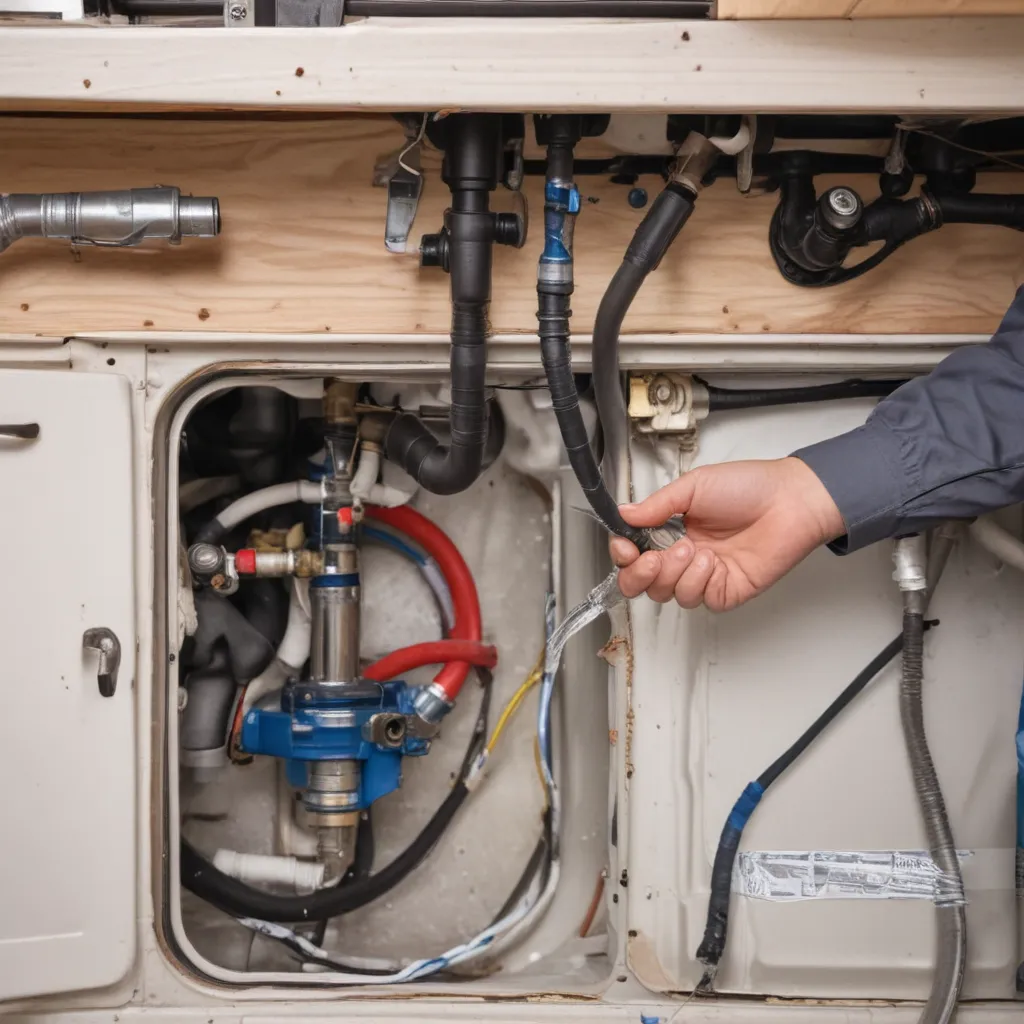
The Waterworks Woes: Tackling RV Plumbing Issues
As the founder and owner of Orange County RV Repair, I’ve seen my fair share of plumbing problems in recreational vehicles. From leaky faucets to clogged drains, these issues can quickly turn a relaxing road trip into a watery nightmare. But fret not, my fellow RV enthusiasts – I’m here to walk you through the most common RV plumbing problems and offer practical, stress-free solutions.
Let’s start with the basics. RV plumbing systems are complex, with a network of pipes, tanks, and fixtures that must work in harmony to provide clean water and efficient waste management. Unfortunately, the constant jostling and vibrations of life on the road can wreak havoc on these delicate systems.
One of the most frequent culprits? Leaks. Whether it’s a dripping faucet, a seeping pipe, or a malfunctioning tank, a leak can quickly escalate into a bigger problem. Not only does it waste precious water, but it can also lead to water damage, mold, and other costly repairs. To tackle this issue, I always recommend conducting a thorough inspection of your RV’s plumbing system, paying close attention to any suspicious wet spots or discoloration. Once you’ve identified the source of the leak, you can use a sealant or replace the faulty component to stop the flow.
Clogged Drains: The Bane of RV Plumbing
Another common plumbing woe in RVs is clogged drains. Over time, hair, soap scum, and other debris can accumulate in your sink, shower, and toilet drains, causing a slow or complete blockage. This can not only be a nuisance but also lead to unpleasant odors and potential water damage.
To tackle a clogged drain, I always recommend starting with a simple plunger. Give it a few good pumps, and you’d be surprised how often that can clear the obstruction. If the plunger doesn’t do the trick, you can try using a drain snake or auger to physically dislodge the clog. Just be careful when using these tools, as you don’t want to damage the delicate plumbing components.
In some cases, the clog may be too stubborn to remove with DIY methods. That’s when it’s time to bring in the big guns – a professional RV plumber. They have the specialized tools and expertise to tackle even the most stubborn blockages, ensuring your drains are flowing freely once again.
Frozen Pipes: A Wintertime Woe
One of the most challenging RV plumbing problems to tackle is frozen pipes. When temperatures plummet, the water in your RV’s pipes can freeze, causing them to expand and potentially burst. This can lead to significant water damage and costly repairs.
To prevent frozen pipes, it’s essential to properly winterize your RV before the cold weather hits. This involves draining the water from your system, adding antifreeze, and insulating any exposed pipes. If you find yourself in the unfortunate situation of having frozen pipes, don’t panic! Gently thaw the affected areas using a space heater or hot air gun, being careful not to overheat the pipes and cause further damage.
Maintaining Your RV’s Plumbing System
Prevention is always the best medicine when it comes to RV plumbing. By regularly maintaining your system, you can avoid many of the common problems we’ve discussed. This includes flushing your tanks, checking for leaks, and ensuring all components are in good working order.
One often-overlooked aspect of RV plumbing maintenance is the water heater. Over time, sediment and mineral buildup can compromise the efficiency and lifespan of this essential component. To keep your water heater in tip-top shape, be sure to flush it out periodically and replace the anode rod as needed.
The RV Plumbing Pro’s Perspective
As an RV plumbing expert, I’ve seen it all – from the comical to the downright catastrophic. But through it all, I’ve learned that the key to resolving these issues is a combination of knowledge, patience, and a good sense of humor.
Take, for instance, the time I got a frantic call from a family whose RV shower had turned into a mini-waterfall. After a quick investigation, I discovered that their young son had decided to “help” by flushing a large number of action figures down the drain. Needless to say, the resulting clog was a doozy, but with a few tricks and a lot of elbow grease, we were able to get the system flowing again.
Or there was the case of the couple who thought their RV’s water tank had sprung a leak, only to realize that they had accidentally left the fresh water valve open, causing a slow but steady stream of water to pour out. A simple adjustment, and their “leaky” problem was solved.
These kinds of quirky situations are all part of the job, and they’re a big reason why I love what I do. There’s always a new challenge to tackle, a new puzzle to solve, and I wouldn’t have it any other way.
Conclusion: Embracing the RV Plumbing Adventure
So there you have it, my fellow RV enthusiasts – a comprehensive guide to tackling the most common RV plumbing problems. From leaky faucets to frozen pipes, I’ve shared my insider knowledge and real-life experiences to help you navigate the sometimes-tricky world of recreational vehicle water systems.
Remember, when it comes to RV plumbing, prevention is key. By staying on top of maintenance, being proactive about inspections, and having a trusted RV plumber on speed dial, you can keep your adventures flowing smoothly (pun intended). And if all else fails, just remember to keep a positive attitude and a good sense of humor – after all, that’s half the fun of the RV lifestyle!
Now, if you’ll excuse me, I’ve got to get back to the shop. There’s a family in need of some serious plumbing TLC, and I wouldn’t have it any other way. Happy (and dry) travels, my friends!
